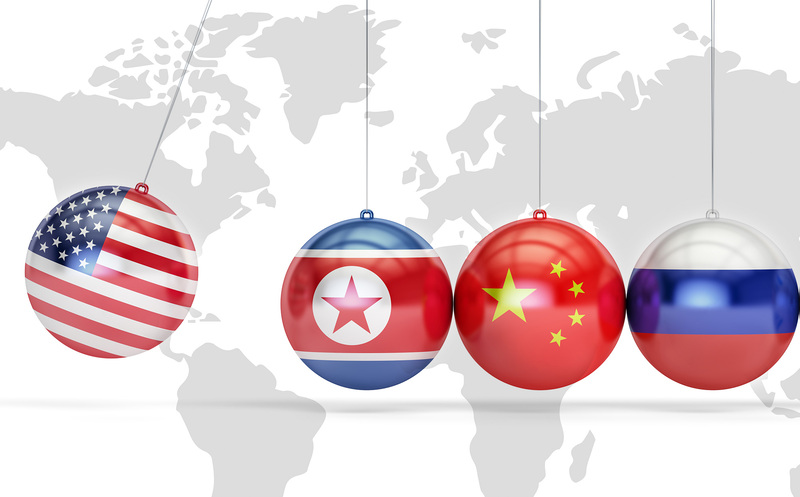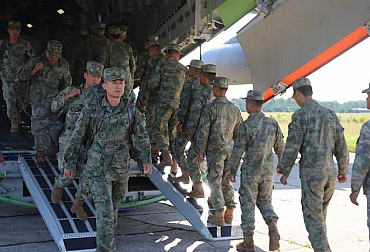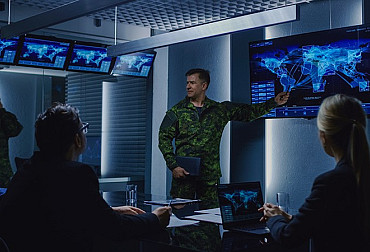Security threats threatening the U.S. in 2024 and their comparison with threats to the Czech Republic
The Office of the Director of National Intelligence recently released its annual unclassified report, "Annual Threats Assessment of the U.S. Intelligence Community," focused on assessing the security threats threatening the U.S. for 2024. Information available as of January 22, 2024 was used in preparing this assessment. The National Intelligence Council is, of course, prepared to support policymakers with additional information in a classified environment.

This annual report on global threats to U.S. national security reflects the collective insights of the U.S. intelligence community, which is committed every day to providing the nuanced, independent, and unvarnished intelligence that policymakers, warfighters, and domestic law enforcement officials need to protect American lives and American interests anywhere in the world. This assessment focuses on the most immediate and serious threats to the United States, especially through 2024, all of which require a robust intelligence response, including those where a focus on the short term can help deter greater security threats in the future.
Most intelligence information is classified - the primary reasons are to protect and defend intelligence assets and to maximize their practical utility by relevant actors. Classification is implemented through various regimes defined in the state secrets system. The choice of the classification level is based on a model of the potential harm to the state that would result from the disclosure or misuse of the intelligence information in question.
Within the Czech Republic, the issue of classified information is addressed by Act No 412/2005 Coll. on the Protection of Classified Information and Security Clearance. According to this Act, classified information is classified as follows:
- a) Top secret, if its disclosure to an unauthorized person or its misuse may cause extremely serious harm to the interests of the Czech Republic,
- b) Secret if its disclosure to an unauthorised person or its misuse may cause serious harm to the interests of the Czech Republic,
- c) Confidential if its disclosure to an unauthorised person or its misuse may cause simple harm to the interests of the Czech Republic,
- d) Reserved if its disclosure to an unauthorized person or its misuse may be disadvantageous to the interests of the Czech Republic.
The processing of publicly available intelligence reports is always a contentious step that requires a special procedure - they should certainly not contain specific factual information to ensure the protection of intelligence sources. In the case of the US annual report, this is created by adequate intelligence synthesis.
Why should we even bother with the US annual report in the Czech Republic?
The security threats to the Czech Republic are similar to the security threats to the U.S., and the U.S. annual report can thus be an interesting complement to Czech intelligence findings - the U.S. intelligence system is much more robust and resourced than the Czech intelligence system, and intelligence production is thus beyond the limited capabilities of Czech intelligence production - but this does not mean that Czech intelligence efforts do not also have interesting intelligence results.
General conclusions of the US annual report
The U.S. Annual Report deals primarily with state actor-led security threats and transnational (transnational) security threats. Its perspective is very realistic (in contrast to some ideological outputs). Let us look at some parts of the US annual report translated into English.
During 2024, the United States will face an increasingly fragile global order that has long been strained by accelerating strategic competition among major powers, intensifying and unpredictable transnational challenges, and multiple regional conflicts with far-reaching consequences. An ambitious but anxious China, a confrontational Russia, some regional powers such as Iran, and more capable non-state actors are challenging the long-standing rules of the international system and US primacy within it. At the same time, new technologies, volatile public health situations, and environmental changes are more common and often have global impacts that are more difficult to predict. One need only look at the crisis in Gaza - triggered by a highly capable non-state terrorist group in Hamas, fueled in part by a regionally ambitious Iran, and exacerbated by narratives promoted by China and Russia to undermine the United States on the global stage - to see how regional crises can have far-reaching spillover effects and complicate international cooperation on other pressing issues. The world that emerges from this tumultuous period will be shaped by who offers the most compelling arguments for how the world should be governed, how societies should be organized, and which systems are most effective in promoting economic growth and delivering benefits to more people, and by the powers - state and non-state - that are most able and willing to act to address transnational problems and regional crises.
From these complex and interrelated issues will emerge new opportunities for collective action with state and non-state actors. The 2024 Annual Threat Assessment highlights some of these contexts by providing the Intelligence Community's baseline assessment of the most pressing threats to U.S. national interests. However, it is not an exhaustive assessment of all global challenges. It addresses traditional and nontraditional threats from U.S. adversaries, a range of regional issues with potentially larger global implications, as well as functional and transnational challenges such as nuclear proliferation, new technologies, climate change, terrorism, and illicit drugs.
China has the ability to compete directly with the United States and U.S. allies and to change the rules-based global order in ways that support Beijing's power and form of government over the United States. Serious demographic and economic problems may make China an even more aggressive and unpredictable global player. Russia's continued aggression against Ukraine underscores that Russia remains a threat to the rules-based international order. Local and regional powers are also seeking to gain and exert influence, often at the expense of neighbours and the world order itself. Iran will remain a regional threat with wider malign influence activities, and North Korea will expand its WMD capabilities while being a disruptive player on the regional and global stage. U.S. actions designed to deter foreign aggression or escalation are often interpreted by adversaries as reinforcing their own perceptions that the United States intends to contain or weaken them, and these misinterpretations can complicate escalation management and crisis communications.
Regional and local conflicts and instability, such as Hamas attacks on Israel and the subsequent Israeli invasion of Gaza, will require U.S. attention as states and non-state actors struggle in this evolving global order, including great power rivalries and shared transnational challenges. Conflicts and bouts of instability from East Asia to Africa to the Western Hemisphere - exacerbated by global challenges - have greater potential to spill over into many regions, with consequences for the United States, U.S. allies and partners, and the world.
Economic pressures are further fueling this instability. Many countries around the world face growing and in some cases unsustainable debt burdens, the economic impacts of the war in Ukraine, and increased cost and production losses due to extreme weather events, even as they continue to recover from the COVID-19 pandemic. While global agricultural food commodity prices have retreated from their 2022 peak, domestic food price increases remain high and food security in many countries remains vulnerable to economic and geopolitical shocks.
At the same time, the world is plagued by a number of common universal challenges that require cooperative global solutions. However, the broader competition between democratic and authoritarian forms of government, which China, Russia and other countries are fueling by promoting authoritarianism and spreading misinformation, is putting pressure on long-standing norms that support cooperative approaches to global public goods. This competition is also using technological advances - such as artificial intelligence, biotechnology and related biosecurity, microelectronics development and production, and potential quantum developments - to exert a stronger influence on global narratives affecting the global geopolitical balance, including influence within it. In particular, the fields of artificial intelligence and biotechnology are developing rapidly, and convergences between different areas of science and technology are likely to lead to further major breakthroughs. The accelerating effects of climate change are putting an increasing proportion of the world's population, particularly in low- and middle-income countries, at greater risk of extreme weather, food and water shortages and humanitarian disasters, fuelling migration flows and increasing the risks of future pandemics as pathogens take advantage of the changing environment.
Interesting specific findings and conclusions of the US annual report
A few states are engaging in competitive behavior that directly threatens U.S. national security, while a larger group of states-including some allies-face domestic conflict or domestic unrest. These pressures and dynamics have the potential to spill across borders and across regions, destabilizing areas and threatening the livelihoods, security, and stability of billions of people. China is vying to surpass the United States in comprehensive national power and secure respect for its preferences from its neighbors and countries around the world, while Russia is directly threatening the United States in an effort to assert influence regionally and globally.
President Xi Jinping envisions China as a leading power in East Asia and as a leading power on the world stage. China's Communist Party will try to prevent its reputation and legitimacy from being challenged, undermine U.S. influence, drive a wedge between Washington and its partners, and promote global norms that favor its authoritarian system. Most importantly, the People's Republic of China (PRC) will press Taiwan on unification, an effort that will create critical friction points with the United States. Despite economic setbacks, China's leaders will maintain statist economic policies to channel capital into priority sectors, reduce dependence on foreign technology, and enable the modernization of the military.
Russia's offensive war against Ukraine has caused enormous damage at home and abroad, but Russia remains a resilient and capable adversary in a number of areas, seeking to advance and defend its interests globally and undermine the United States and the West. Strengthening Russia's ties with China, Iran, and North Korea to bolster its defense production and economy is a major challenge for the West and partners. Russia will continue to pursue its interests in competitive and sometimes confrontational and provocative ways and to exert pressure to influence other countries in the post-Soviet space to varying degrees.
- Russia almost certainly does not want direct military conflict with US and NATO forces and will continue to engage in asymmetric activity below what it calculates to be the threshold for military conflict worldwide. President Vladimir Putin likely believes that Russia has blunted Ukrainian efforts to regain significant territory, that its approach to winning the war is paying off, and that Western and U.S. support for Ukraine is finite, especially in light of the war between Israel and Hamas.
- Putin's large-scale invasion of Ukraine has turned Russia's geopolitical, economic and military recovery upside down and damaged its international reputation. However, Russia is putting policies in place to mitigate these costs and is using foreign relations to minimise the damage of sanctions and restore its credibility as a great power.
- Moscow's deep economic engagement with Beijing provides Russia with a significant market for its energy and commodities, greater protection from future sanctions, and a stronger partner in opposition to the United States. China is by far Russia's most important trading partner, with bilateral trade reaching more than $220 billion in 2023, already surpassing its 2022 record total by 15 percent.
Iran will continue to threaten U.S. interests, allies, and influence in the Middle East and intends to consolidate its emerging status as a regional power while minimizing threats to the regime and the risk of direct military conflict. Tehran will attempt to leverage recent military successes through its emboldened network of threats, diplomatic gains, expanded nuclear program, and military sales to advance its ambitions, including seeking to further strengthen relations with Moscow. Iran will seek to use the Gaza conflict to denounce Israel, denounce its role in the region and attempt to dissuade other Middle Eastern states from warming relations with Israel, while trumpeting to the world Iran's role as a champion of the Palestinian cause. But Iran's stance on the conflict is unlikely to mask the problems it faces internally, where the regime is still being tested by economic underperformance and social injustices.
North Korean leader Kim Jong-un will continue to pursue nuclear and conventional military capabilities that threaten the United States and its allies, allowing for periodic aggressive actions as he seeks to reshape the regional security environment in his favor. North Korea has emerged from its deepest period of isolation due to a combination of nearly two decades of severe UN sanctions and voluntary restrictions on the free movement of people in the wake of the COVID-19 pandemic. Today, it is seeking stronger ties with China and Russia to increase financial gains, diplomatic support, and defense cooperation. Kim almost certainly has no intention of negotiating the abolition of his nuclear programme, which he regards as a guarantee of regime security and national pride. Moreover, Kim probably hopes to be able to use his bourgeois defence ties with Russia to achieve his goal of achieving international recognition as a nuclear power.
The potential for interstate conflict and domestic unrest in other countries around the world also continues to pose a challenge to U.S. national security, both directly and as a threat to our allies and partners. The rising tensions and instability from these flashpoints may be exacerbated by intensifying global power competition given the complex and interconnected security environment. Conflicts, particularly those that disrupt global trade and investment flows, could lead to rising energy prices and increased economic instability even in countries not directly involved in or far removed from the conflict. For example, tourism, which is a major source of foreign exchange for Egypt, Jordan and Lebanon, has fallen sharply since the Gaza conflict began, and the disruption of Ukrainian food exports in 2022 has helped fuel rising global food prices. Regional and local conflicts have far-reaching and sometimes cascading consequences not only for neighbouring countries but also for the world. In addition to being an illustrative example of this phenomenon, the ongoing conflict in Gaza also highlights the potential for spillover into a larger and more dangerous conflict.
Transnational threats interact in a complex system with threats from state actors, often reinforcing each other and creating combined and cascading risks to U.S. national security. Growing interconnectedness among countries has also created new opportunities for transnational interference and conflict. A few clear and direct challenges are the rapid development of technology, the spread of repression across physical borders, the threats posed by transnational organized crime and terrorism, and the societal impacts of international migration.
New technologies - particularly in the fields of artificial intelligence and biotechnology - are developing and spreading at a speed that makes it difficult for societies and governments to shape norms on civil liberties, privacy and ethics. The convergence of these emerging technologies is likely to lead to breakthroughs that could lead to the rapid development of asymmetric threats - such as advanced drones - to U.S. interests and likely help shape U.S. economic prosperity.
Advances in artificial intelligence and new machine learning models are propelling AI into its industrial age, with potentially huge economic implications for winners and followers, and unintended consequences - from rampant deepfakes and disinformation to the development of AI-generated computer viruses or new chemical weapons. Generative AI is a means to discover and design new technologies and advanced system-level processes that could enhance a country's technological, economic, and broader strategic competitiveness.
U.S. persons and interests at home and abroad will face an ideologically diverse terrorist threat. This threat will most likely manifest itself in small cells or individuals inspired by foreign terrorist organizations and violent extremist ideologies to carry out attacks. While al-Qaeda has reached operational lows in Afghanistan and Pakistan and ISIS has suffered cascading leadership losses in Iraq and Syria, regional affiliates will continue to expand. Terrorists will be interested in conducting attacks using chemical, biological, and radioactive materials against U.S. persons, allies, and interests around the world. Terrorists from diverse ideological backgrounds continue to disseminate instructions on social media and online forums of varying credibility to procure or produce toxic or radioactive weapons using widely available materials.
Private military and security companies (PMSC)
SVBS jsou v mezinárodním prostředí stále více přítomny a hrstka těchto firem spojených s americkými rivaly, jako je Rusko, ohrožuje globální bezpečnost v mnoha zemích a regionech prostřednictvím své schopnosti potenciálně podněcovat násilí a eskalovat nestabilitu v již tak křehkých regionech
- PMSC se staly nezbytnou součástí moderních vojenských operací a poptávka po jejich službách pravděpodobně poroste. Největší část průmyslu tvoří korporace, které poskytují nájemné bezpečnostní služby pro komerční zájmy nebo státy. Čína, Rusko, Turecko a Spojené arabské emiráty však považují PMSC za cenný nástroj ve svém arzenálu pro prosazování nebo ochranu svých zájmů v zahraničí.
- Mnoho vlád bude vzhlížet k tomu, že PMSC budou hrát důležitou roli jako multiplikátor síly pro jejich konvenční armády – plnění vysoce technických úkolů nebo úkolů náročných na lidské zdroje, jako je údržba, logistika nebo zabezpečení pevných míst – nebo v některých případech poskytování vysoce specializovaných schopností přímé akce na klíč, které v jejich silách chybí.
Conclusions and recommendations for the Czech Republic
- 1) In order to maintain adequate technological superiority of the Czech security and defence forces, it is necessary to continuously monitor the scientific research and innovation environment in the world (new intelligence priority = scientific research and innovation intelligence and counter-intelligence protection and defence of the scientific research and innovation potential of the Czech Republic).
- 2) Within the Czech news environment it is necessary to actively develop especially the skills of news prediction and synthesis.
- 3) The Czech intelligence system should jointly evaluate the potential and generated risks for security threats to the Czech Republic on an annual basis - on this objective basis, the Czech security system must then provide further security for the Czech Republic.
- 4) In order to maintain and further strengthen the strategic and operational value of the Czech security system, it is necessary to ensure very quickly the process and resource optimisation of the innovation ecosystem for the security and defence of the Czech Republic.
- 5) It is necessary to start actively looking for a new open model for providing global security guarantees for states in a multipolar environment (otherwise there will be a steady increase in resource needs for security provision, the financing of which will require cutting the resources of other public interests of states or the growth of further indebtedness of states).





















